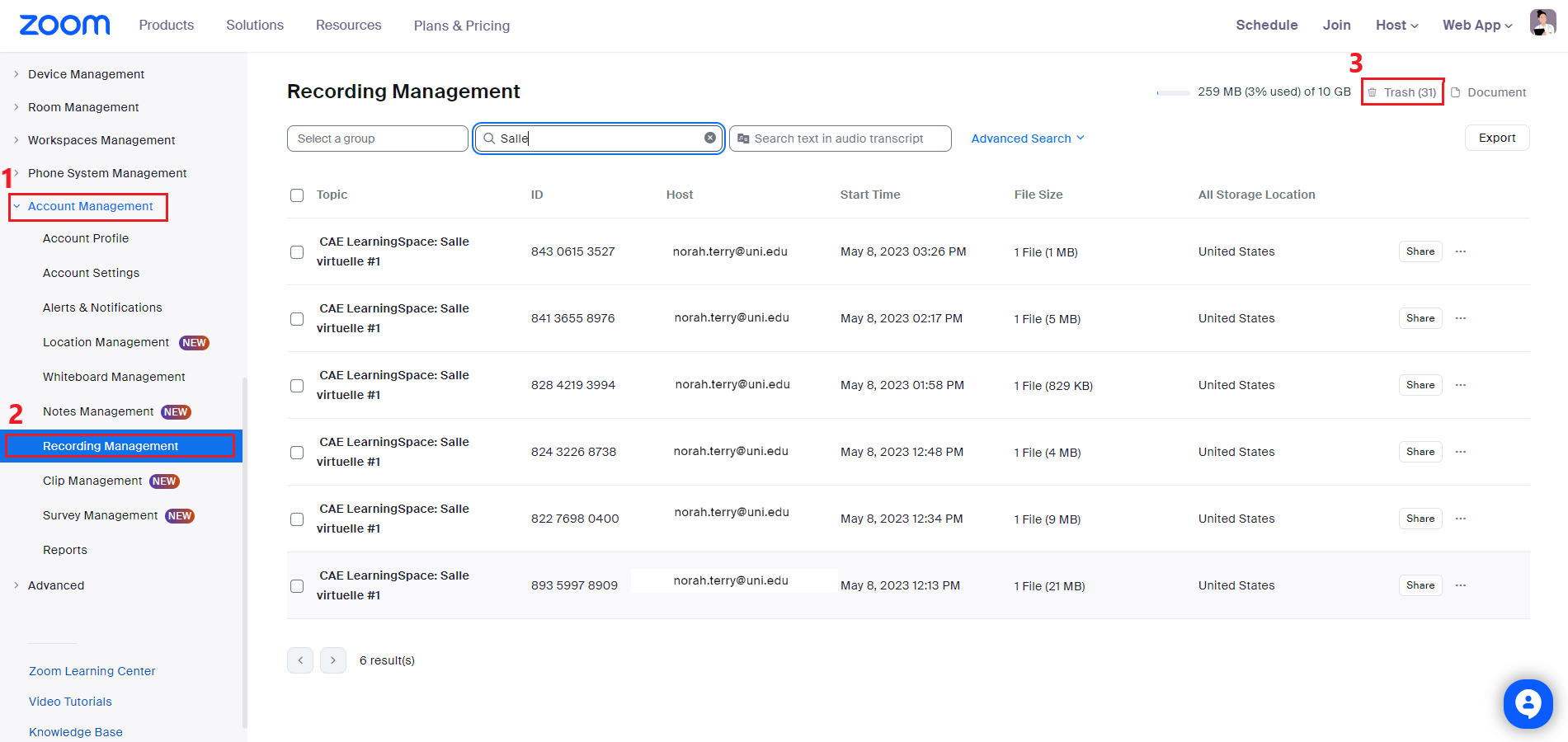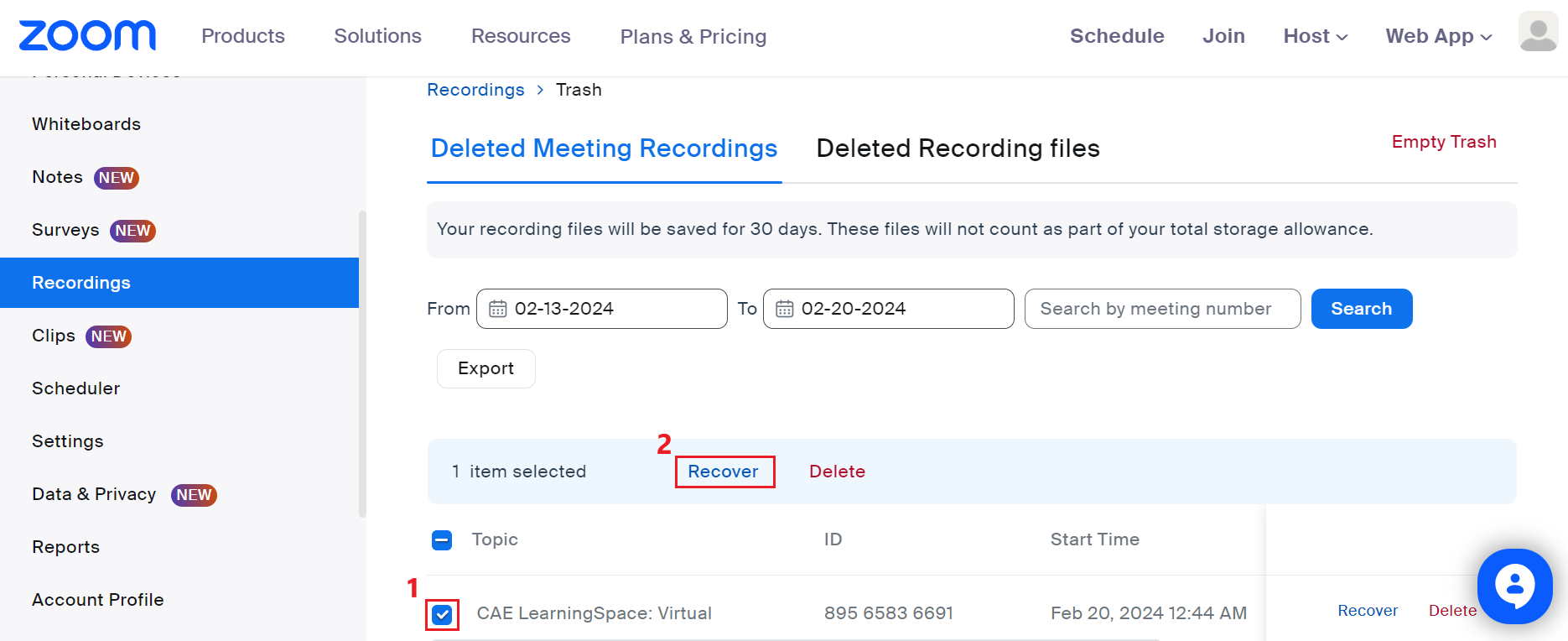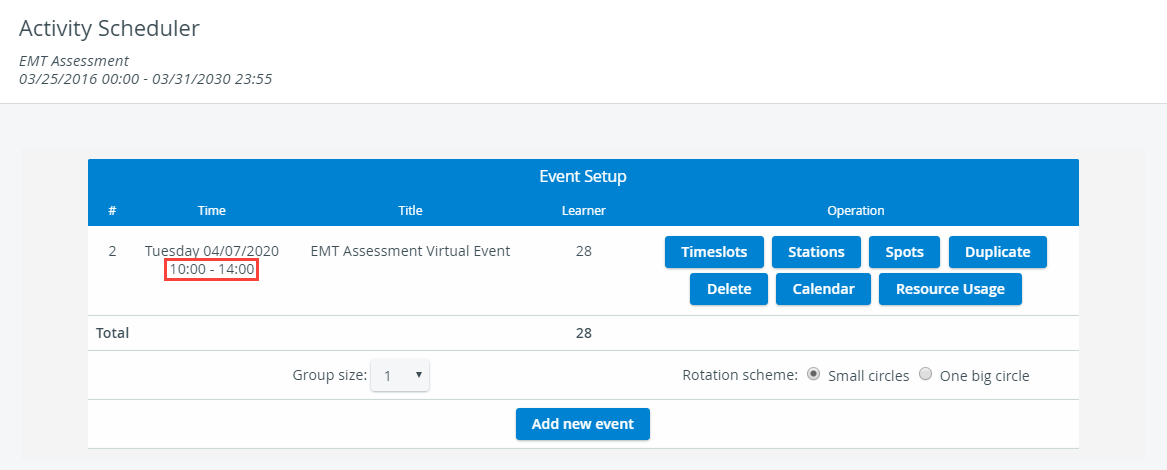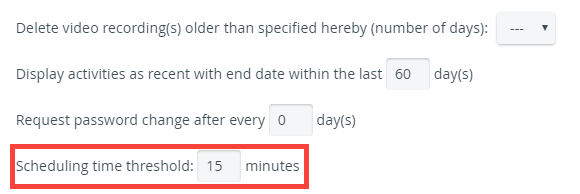This page will walk you through the most significant changes made to the LearningSpace Enterprise system to accommodate distance learning:
- here, you can go through the steps of creating a virtual event;
- also, you will find further essential setting options that you can apply to optimize the virtual OSCE workflow:
Create users with combined Activity Manager + SRP or + SRP (full control) privileges. With this combination, the user can edit the activity that was |
Important Changes
1. Renewed Pre-Selection Pages
The Case Pre-Selection (for learners) and Learner Pre-Selection (for SPs) pages contain new options:
Pre-Selection pages are only available for SPs and learners from the start to finish of the event they are assigned to.
Basic case selection page without virtual event details This might result in accidentally filling out the wrong checklist. Also, SPs will not be able to access the renewed Learner Pre-Selection page prior to or after the event. |
Start/Stop meeting options for SPs to start hosting or end the virtual encounter from LearningSpace.
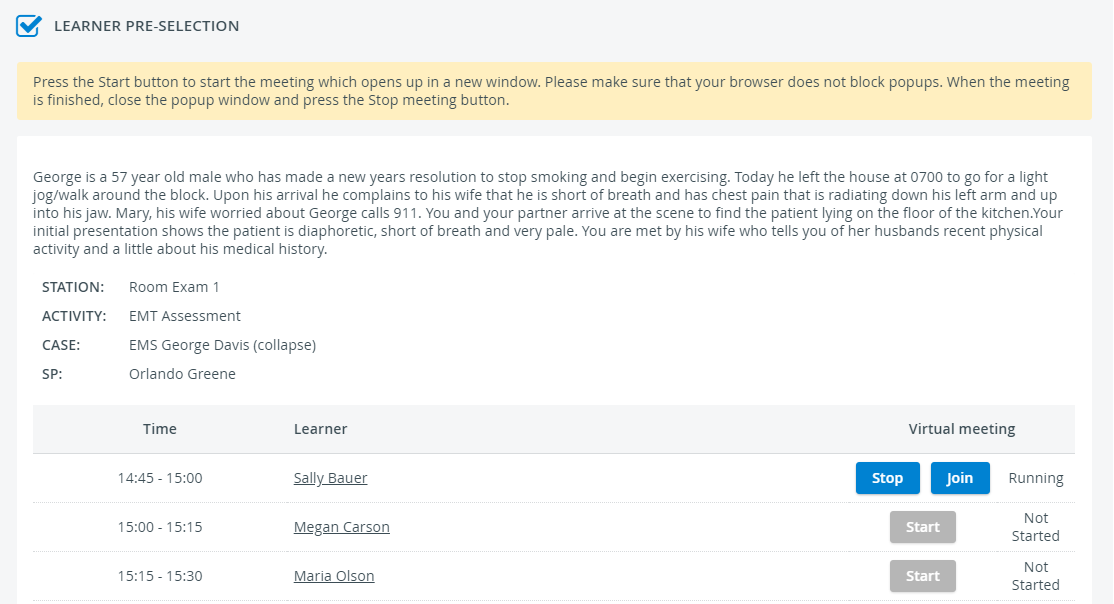
SPs need to end the meeting with the End Meeting for All option in Zoom and the Stop option in LearningSpace to allow learners access to their post-encounter checklist.
Otherwise, video processing will not start, and learners will be presented with the following message when trying to access their post-encounter checklist:
- Join option for learners to each virtual case listed by the timeslots the learners were assigned to.
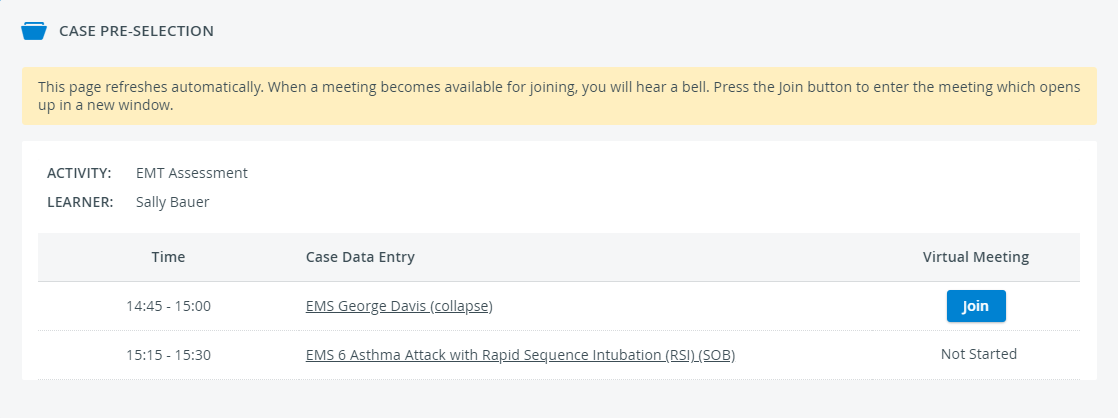
2. Virtual Rooms Instead of Authorized Workstations
a. Virtual Rooms Cannot be Used as Authorized Workstations
In a distance learning environment, virtual rooms cannot be applied as authorized workstations since every participant of the activity logs into LearningSpace on their personal devices.
Consequently, there are specific Options in the activity editor that must be avoided:
Do not restrict data entry to specific computers based on their IP address or hostname endings.
Make sure "Data entry only allowed from..." setting is unchecked.
Do not allow data entry from manually authorized workstations.
Make sure "Data entry only allowed from manually authorized workstations" setting is unchecked.
b. About the Devices Meetings Are Accessed From
An important restriction applies to the devices used by the participants attending a virtual LearningSpace event: the devices the virtual meetings are accessed from cannot be added to LearningSpace as a station.
The selected meeting provider will not open on the devices that are added as stations to LearningSpace. This means that SPs will not be able to start meetings, and learners and observers will not be able to join a running meeting.
Check the Stations tab in your LearningSpace system for every added device. If there are devices added that will be used by SPs or learners for connecting to virtual events, remove them with the Delete button.
Identify the devices by their names or IP addresses displayed in the Stations tab. |
c. No Automatic User-Forwarding
Upon login, SPs and learners are not automatically forwarded to the
- Case Pre-Selection page (for learners) and
- Learner Pre-Selection page (for SPs).
This limits automated data entry presentation to these users.
During the event, SPs and learners need to go to their Dashboards and click SP Data Entry or Data Entry next to the activity they are participating in—as explained in the standardized patient and medical student guides—to access their Pre-Selection pages. |
3. Video Processing
Virtual event recordings are first saved to Zoom: they are stored temporarily in the cloud of your Zoom owner account. Once recording files are saved to the cloud, LearningSpace begins video processing and downloads the duplicates of the recordings through a secure HTTPS channel to the Video Review module.
Virtual encounter recordings are not available in Video Review until video processing is finished. |
When the recordings arrive in the Video Review module, the original video recording files are moved to the Trash folder in your Zoom account:
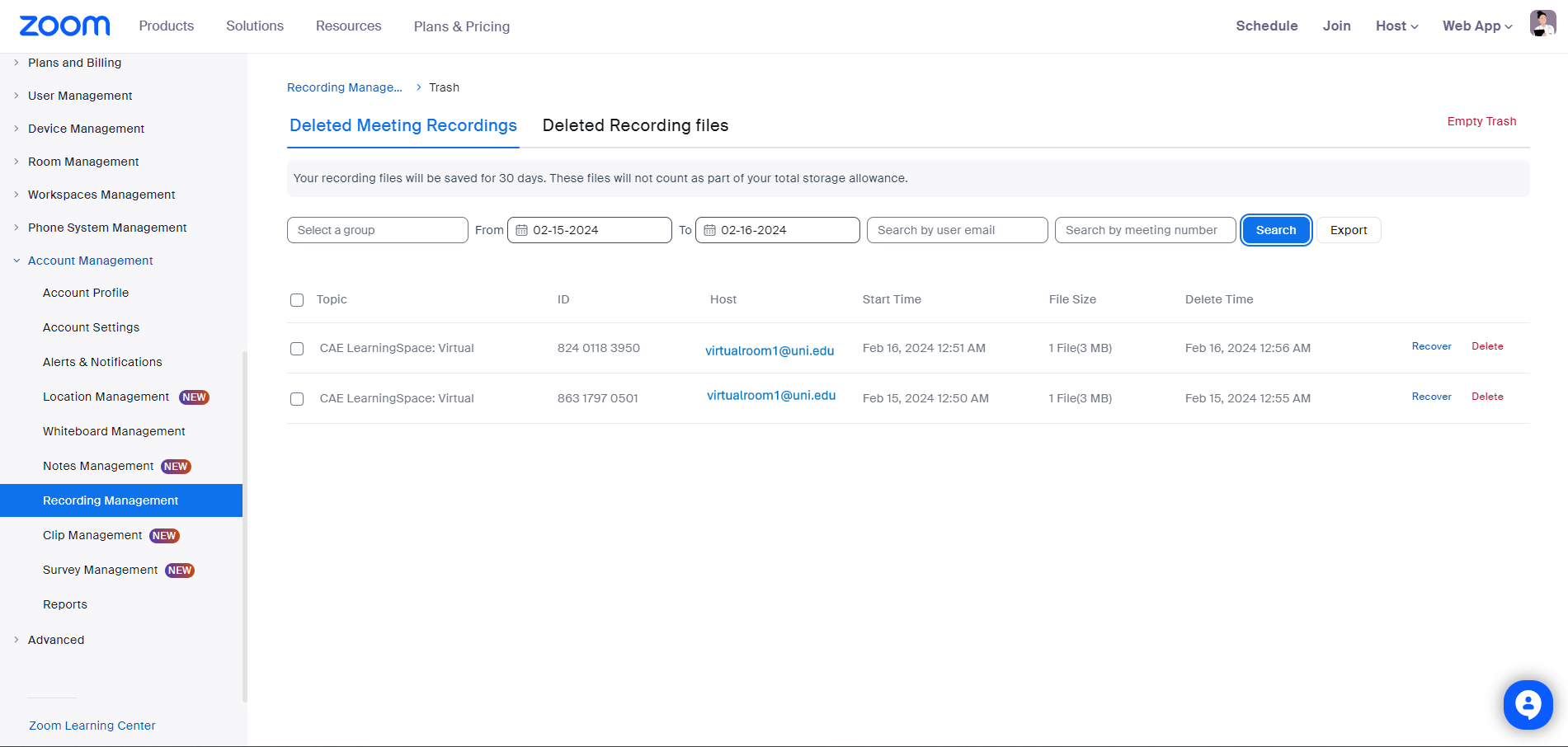
This is the default setup of the Zoom virtual room integration to always leave you with enough storage in the cloud for your virtual encounter recordings. |
Would you like your cloud recordings to remain in the Recording Management folder after they arrived in the Video Review module? Upon your request, we can disable the automatic transfer of Zoom cloud recordings to Trash. Contact LearningSpace Customer Service for more information. |
Downloading virtual event recordings from Zoom's cloud to LearningSpace might take some time, but if you notice that the recordings have not arrived in the Video Review module within 6 hours, you can retrieve the meeting recordings and upload it to LearningSpace manually:
11. Hover over a file to download it or to access further options.
12. After downloading the video, you can upload it to the Video Review module. |
Virtual encounter recordings display the host and participant—SP and learner—side-by-side. |
LearningSpace adds annotations to the recordings to let you know when the learner has joined the virtual encounter. |
Recommended Activity Settings
1. Pre-Selection Page Display
a. Virtual Event Access through Your Activities
When selecting cases for virtual events, make sure that the cases you add to an activity contain each of the following checklists:
- SP checklist
- Pre-Encounter checklist and
- Post-Encounter checklist
Otherwise, SPs and learners might not be able to access their pre-fill pages on the Your Activities pane, or their pre-fill pages might not list every meeting they are supposed to attend.
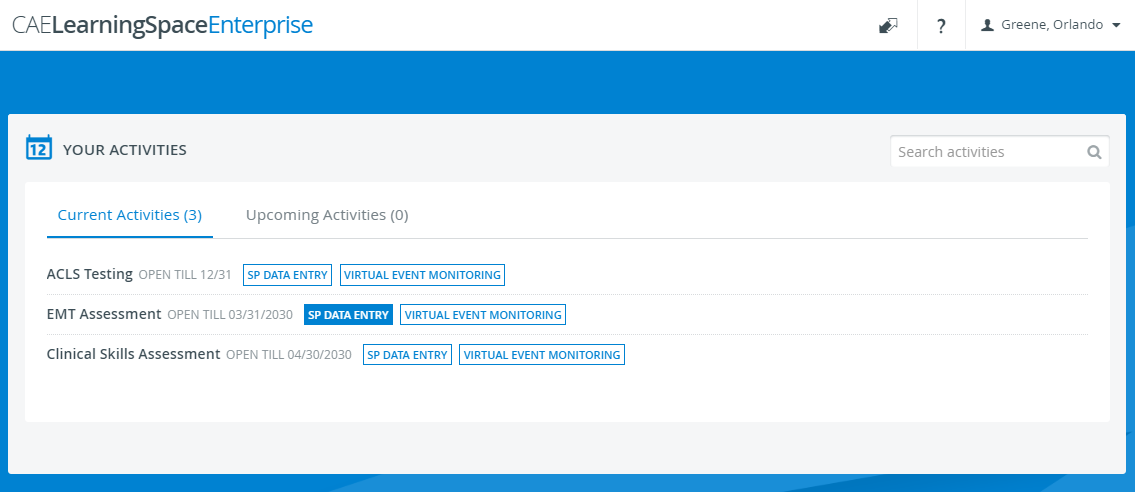
b. Time Limitations of Pre-Selection Page Access
Pre-Selection pages are only available for the duration of an event.
Otherwise, SPs and learners can only access data entry from their basic data entry selection pages where they have to select a learner or a case from a drop-down manually.
If there is no scheduling time threshold set up, some learners will have less time than others to fill in their checklists on their Case Pre-Selection pages: namely, the learners who are scheduled for the first or last timeslots of an event. Also, without a scheduling time threshold, SPs will not access their Learner Selection-Page to complete data entry following their last virtual encounter. |
To enable SPs and learners to access their Pre-Selection pages before and after an event for some extra time, set up a scheduling time threshold.
|
|
2. Limit the Availability of Learner Data Entry
Even if you ensure that learners have plenty of time to access their Case Pre-Selection pages during the event, they can still access data entry during the entire activity.
If they access Data Entry outside of the event and the scheduling time threshold, they will land on the basic case selection page without the context of the event they are assigned to.
Align the activity's entire duration with the event's duration extended by the scheduling threshold:
|
3. Disable Post-Encounter Checklist Access Before the Virtual Encounter
After setting up the time restrictions to Pre-Selection pages, prevent learners from opening their post-encounter checklist before their virtual encounter.
Select the "Allow Post-Encounter access only after student encounter" in the Options tab of the activity. |
When the option is selected, learners can only access their post-encounter checklist if one of the following conditions is met:
- The learner’s virtual encounter with the SP has been ended with the red Stop button by the SP on the Learner Selection page
The video recording does not have to be fully processed for learners to have access to their post-encounter checklist. |
OR
- The SP checklist of the Case assigned to the virtual event has been submitted by an SP
OR
- The FON checklist of the Case assigned to the virtual event has been submitted by a FON Data Entry user
Without selecting this option, learners will be able to access their post-encounter checklist anytime while on their Pre-Selection page e.g. without attending their scheduled virtual encounter. |
Virtual Event Setup
Create a new event with Advanced Scheduling.
Virtual encounters can only be set up in Advanced Scheduling.
Optional Change the group size.
From now on, you can define a group size greater than 1 for your scheduled virtual events, which means multiple learners can participate in the same virtual meeting.
By increasing the group size, you allow more learners to be assigned to the same timeslot. This also means that the number of spots dedicated to an event will multiple by the selected group size.
The number of maximum spots for an event is displayed in the Learner column.Access your activity in Advanced Scheduling, and in the footer of the Event Setup pane, click the Group size drop-down to change the maximum number of learners per timeslot for your events:
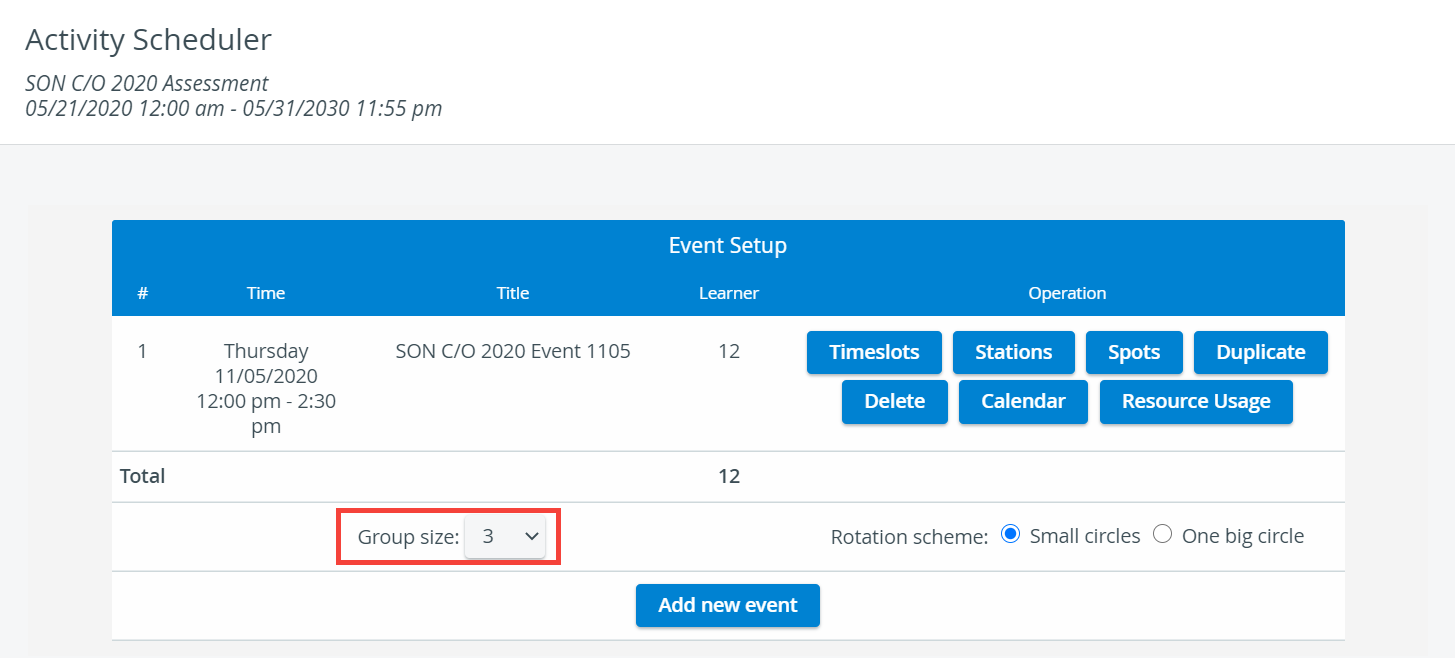
Changing the group size affects every event of the activity.
If you increase the group size compared to the previous setup, there is no need to reorganize the learner assignments of other events where appointments have already been finalized; assignments for other events remain intact in case of increasing the group size.
If you decrease the current group size, make sure to revise the learner assignments of other upcoming events: when decreasing the group size, some learners who were scheduled while the larger group size was being applied may lose their guaranteed spot.
Learners without a valid spot appear in violet fields at timeslots inside Generate Assignments:
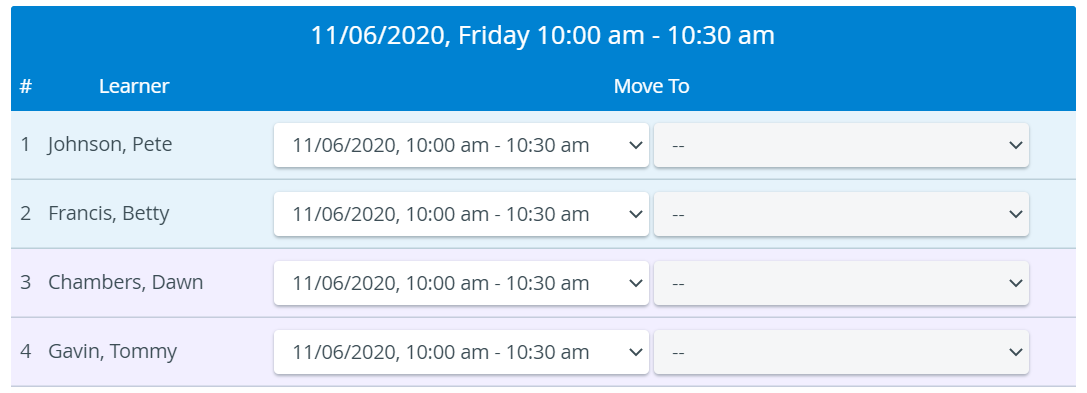
Set up timeslots and have valid round setups.
To allow your learners to join the virtual meeting of each case required of them, the number of timeslots within a round should be equal to (or the multiple of) the number of virtual cases.
This will ensure the correct rotation of learners: within one round, every one of them can participate in each virtual encounter they need to complete.Add one virtual room to each case at Stations.
You can conduct the same case in several different virtual rooms just as running the same case on more than one station.
Likewise physical rooms, you cannot assign the same virtual room to more than one case.
Do not add physical rooms to your virtual event or add virtual rooms and physical rooms simultaneously to virtual events.
Only virtual rooms work in this setting.Virtual rooms do not function as authorized workstations, which means automatic user-forwarding to pre-selection pages is not provided.
Learners can still access their checklists, but they have to manually select their case from a drop-down menu, which might lead to mistakes in data entry.Refer to the Recommended Activity Settings mentioned above to direct your learners to the Case Pre-Selection page.
- assign learners and
You can assign more than one SP to the same virtual room.
Use the plus sign at SP assignments in Scheduling to add SPs:

Every assigned SP will have the same Learner Pre-Selection page displayed and everyone can potentially control meetings:
- start a virtual meeting if no one else has started one yet,
- join a running session,
stop a session if no one else has done so.
However, virtual rooms allow only one meeting at a time. Only one SP can start a meeting while others will not be able to launch simultaneously other meetings.
Once one of the SPs starts a virtual meeting with a learner, all other learner appointments will be disabled:
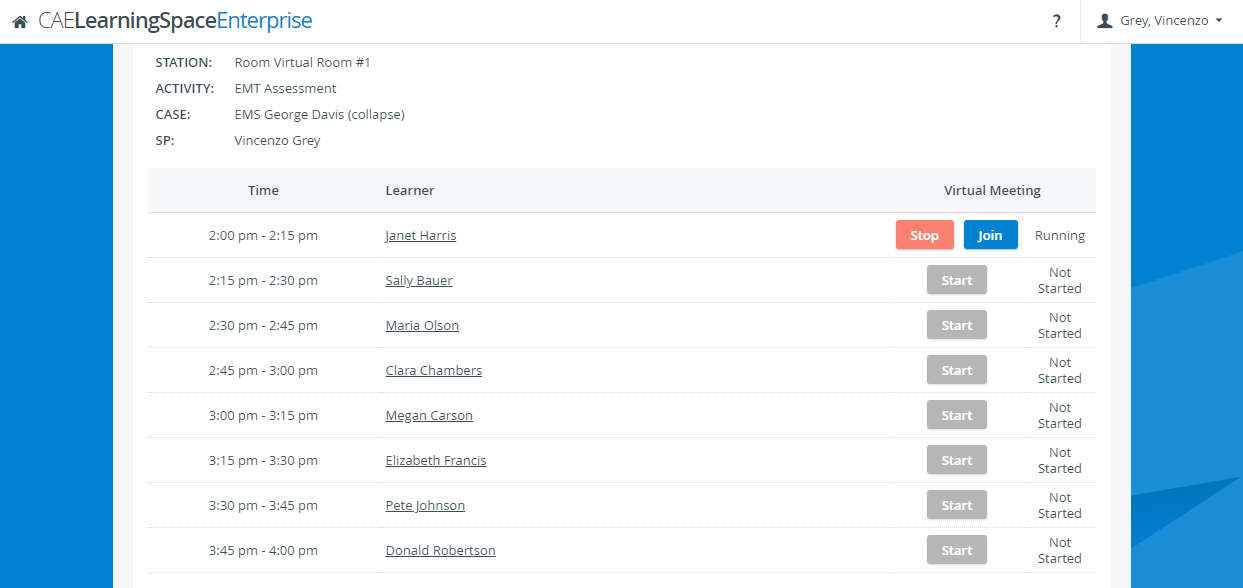
Make sure that the SP who is portraying the scenario controls the virtual encounter.
Do not apply a timeslot structure template to your event.
SPs are in charge of launching and ending virtual encounters.
Notify Learners about Their Exact Timeslot Schedule
After assigning learners to timeslots, send the exact virtual encounter dates to your learners via notification emails.
From now on, in your event notification emails, you can inform learners about the exact timeslots they are assigned to. A new merge tag is available in the Emails tab in System: Learner timeslot that displays the timeslot date(s) the recipient is assigned to. |
- Scroll down to Notification emails on the Activity Scheduler page:
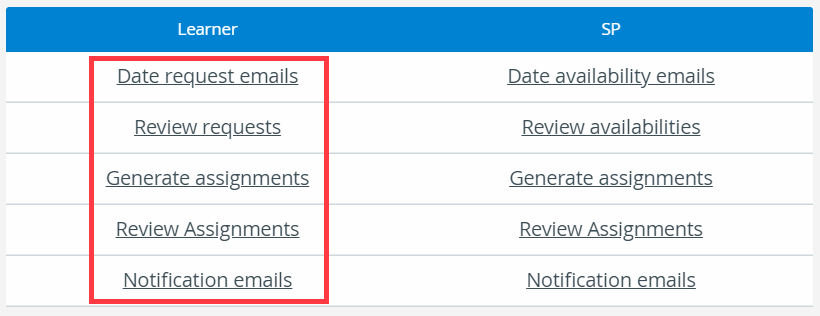
You will be redirected to the Scheduling (Learner assignments) page, where you can edit the notification email you are going to send out to the learners. Select a from address in the Email From drop-down.
To set up further from addresses, go to the Emails tab in System Manager.
- Enter the subject of your email in the Subject field.
- Edit the message body of your email in the Message field.
- While editing your message, apply the new Learner timeslot merge tag.
To apply the new merge tag, you first need to create the Learner notification email template in Emails:
- Click on the System Settings button at the bottom of the page to access the Emails tab in System.

- Select "Learner notification email" from the Email templates drop-down:
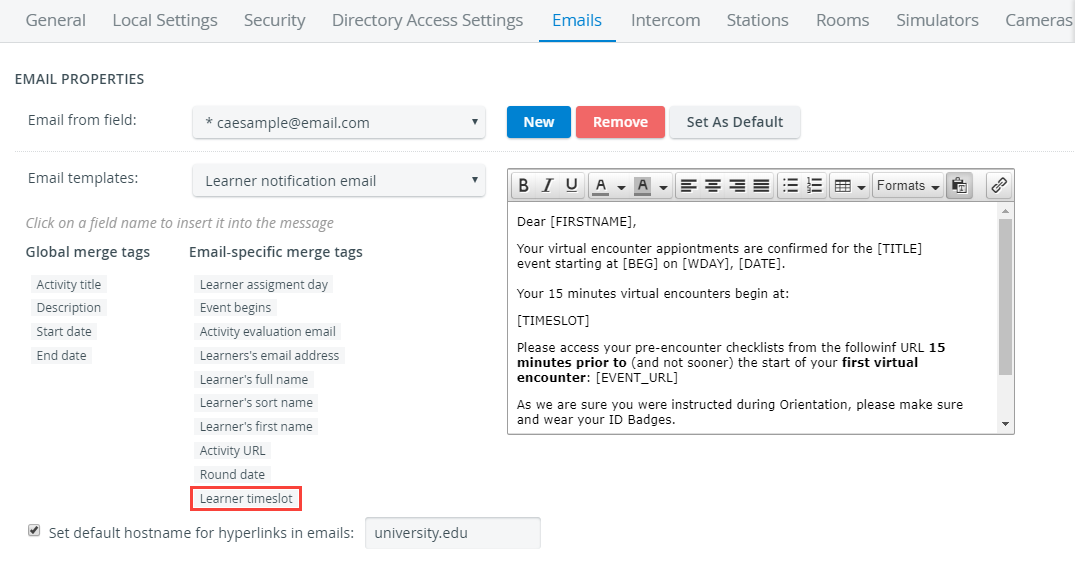
- While editing the template, click on the Learner timeslot tag to add it to your message.
Return from the Emails tab to your event notification email setup using the back arrow.
The timeslot (#{TIMESLOT}#) tag will be added to your message: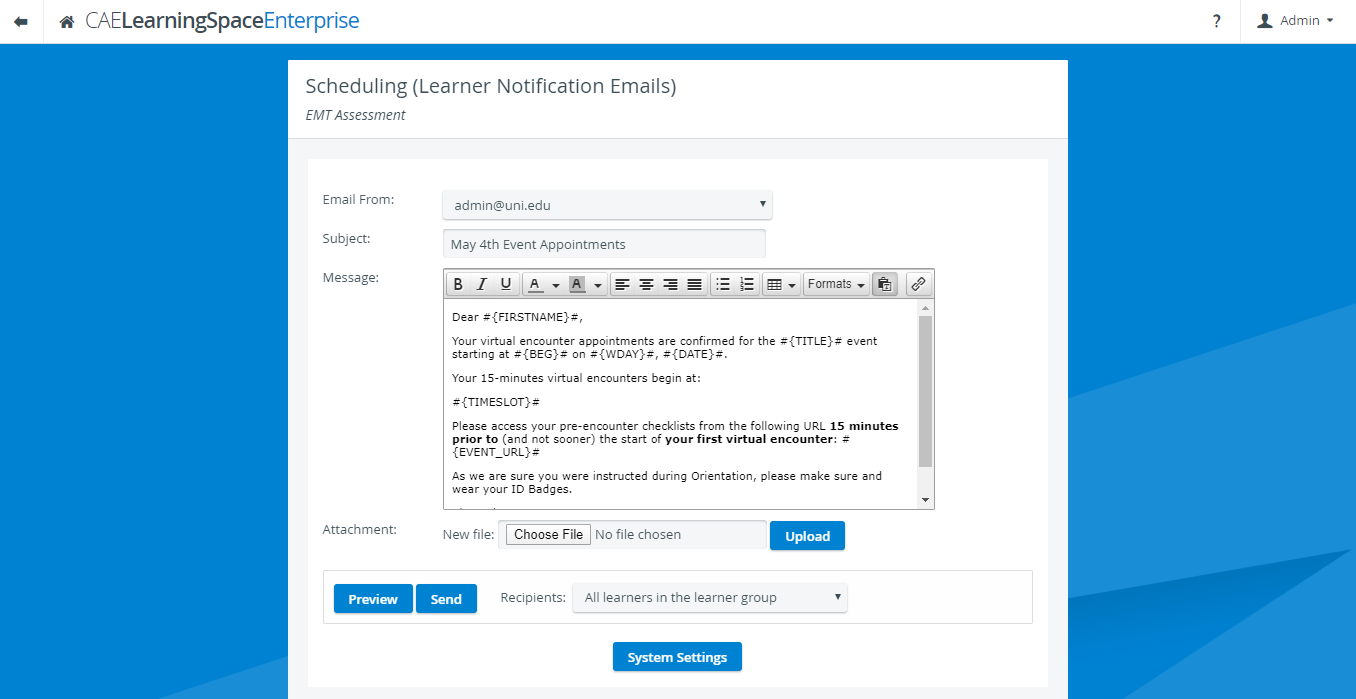
- Click on Preview to see how your email will be displayed to each of your recipients.
The Email Preview page displays your message by each user.
The timeslot merge tab will list every timeslot a learner has been assigned to: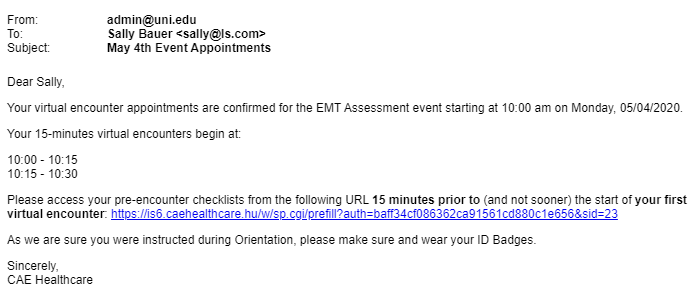
Return to editing with the back arrow. - Select a recipient group from the Recipients drop-down.
Click Send.
After you have sent out the date request emails, the system will log the time and date of sending.
Learn more on our Distance Learning with LearningSpace pages. |

